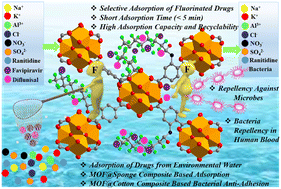Superhydrophobic nanosized metal–organic framework composites for the targeted removal of hydrophobic pharmaceuticals with outstanding bacterial anti-adhesion properties†
Abstract
The increasing concentration of pharmaceutical waste after the COVID-19 pandemic has accelerated the urgency of removing various drugs from environmental water specimens. Realizing this concern, herein, a nanosized superhydrophobic metal–organic framework (SH-MOF) material was synthesized and its activated form (SH-MOF′) was used for the selective removal of two widely used drugs, i.e., favipiravir (a potential COVID-19 drug) and diflunisal. The reusable MOF has very high adsorption capacities towards favipiravir and difunisal i.e., 86.5 and 148 mg g−1, respectively, within 5 min. The MOF also adsorbs drug molecules in highly acidic and alkaline media with almost equal efficiency. The porous nano-sized MOF shows high selectivity towards the adsorption of favipiravir and difunisal over the common ions and hydrophilic drugs. To make the adsorption process more user-friendly, a MOF-coated sponge composite was developed and utilized for filtration-based drug separation. Moreover, the superhydrophobic MOF and silver nanoparticle-coated cotton composite was fabricated which displayed excellent bacterial anti-adhesion and anti-bacterial properties towards Staphylococcus aureus bacteria.

- This article is part of the themed collection: RSC Environmental Science journals: Highlights from India


 Please wait while we load your content...
Please wait while we load your content...